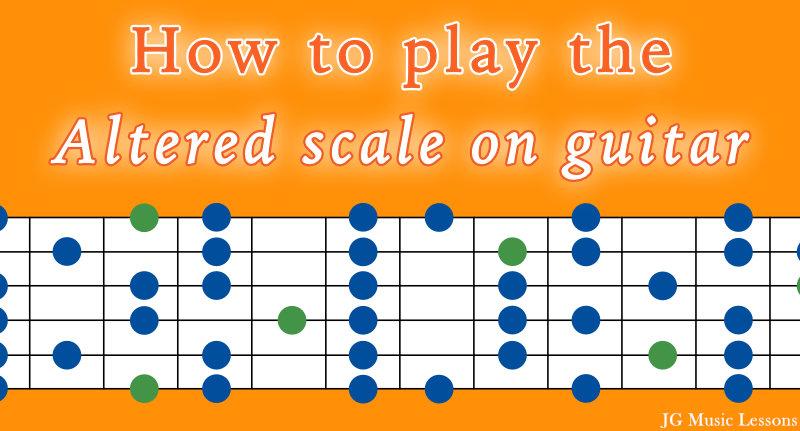The altered scale is one of the essential scales to know in jazz and improvisation. This scale is especially useful when playing over altered chords which include chord extensions such as the b9, #9, #11, or b13.
In this lesson, we cover the music theory on the altered scale, how to play them in different keys, learn the five shapes throughout the fretboard, and musical examples to help you apply them on guitar.
Let’s get started!
What is the altered scale?
The altered scale is a set of 7 notes based on the following scale degrees related to the root note: 1, b2, b3, 3, b5, b6, and b7.
An easy way to think of the notes in an altered scale is to think of the melodic minor scale a half step above.
For example, for a B altered scale, think of the C melodic minor scale starting on the 7th degree. The notes would be B, C, D, Eb, F, G, A, and B.
Altered scale formula
In terms of whole and half steps, the altered scale formula would be half, whole, half, whole, whole, whole (see the image below).

Altered scale examples
Now let’s apply the altered scale formula to different keys. Each scale below will cover two octaves on the guitar in standard notation with tabs and audio examples included.
Even though these examples are written 4/4 time, you can apply the notes to any time signature.
A altered scale example

G altered scale example

E altered scale example

Altered scale chart in all 12 keys
Here is a chart of the altered scale in every key.
| Altered scale | 1 | 2 | b3 | 3 | b5 | b6 | b7 |
|---|---|---|---|---|---|---|---|
| C altered scale | C | Db | Eb | E | Gb | Ab | Bb |
| D altered scale | D | Eb | F | Gb | Ab | Bb | C |
| E altered scale | E | F | G | Ab | Bb | C | D |
| F altered scale | F | Gb | Ab | A | B | Db | Eb |
| G altered scale | G | Ab | Bb | B | Db | Eb | F |
| A altered scale | A | Bb | B | Db | F | Gb | G |
| B altered scale | B | C | D | Eb | F | G | A |
| Db altered scale | Db | D | E | F | G | A | B |
| Eb altered scale | Eb | E | Gb | G | A | B | Db |
| Gb altered scale | Gb | G | A | Bb | C | D | E |
| Ab altered scale | Ab | A | B | C | D | E | Gb |
| Bb altered scale | Bb | B | Db | D | E | Gb | Ab |
Now that you have a better understanding of the music theory behind altered scales, let’s start learning the 5 scale shapes throughout the fretboard.
5 altered scale shapes on the guitar
We can break down the altered scale into 5 different sections of the guitar fretboard. You can play these shapes starting on any root note.
How to read the scale charts
For the charts below:
- The lowest horizontal line represents the thickest string (Low E). The top horizontal line represents the thinnest string (high E).
- The green circles represent the root note of the altered scale and the blue notes are every scale note in between.
- The numbers inside the circles represent the suggested fingering to use on your fretting hand.
If needed, check out how to read guitar notation symbols.
Altered scale shape 1
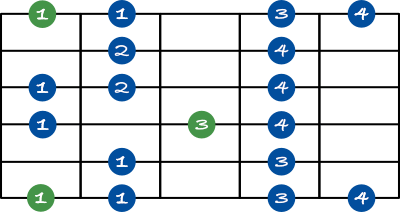
Altered scale shape 2
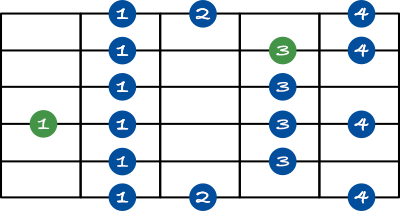
Altered scale shape 3
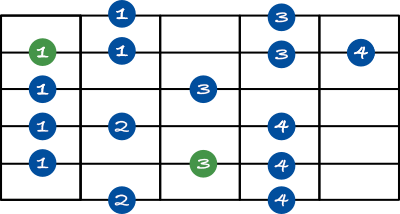
Altered scale shape 4
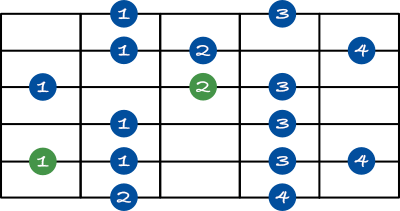
Altered scale shape 5
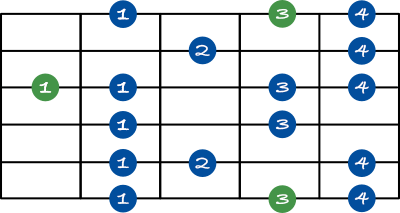
One thing to note about using these shapes is that whenever you have scales where you can use open strings, you will have to rearrange your fingers to play the shape. For example, if a shape includes the fingering 1, 3, and 4 on one string, you can play (open string), 1, and 3 instead.
Although you will need to change some shapes if you include open strings, once you move over to the next shape where you’re fretting all the notes, you will get back to the original shapes we covered here.
Altered scale application examples
The following examples show you how to apply the altered scale over a dominant chord with added chord tensions. We’ll be using the A altered scale over the A 7 (b13) chord which resolves to a D minor 7 chord. This is a 5 to 1 chord resolution in the key of D minor.
Examples 1, 2, and 3 use the altered scale for one measure before resolving to the 1 minor chord.
Altered scale example 1

Altered scale example 2

Altered scale example 3

Altered scale example 4
Examples 3 and 4 use the altered scale for two measures before resolving to the 1 minor chord.

Altered scale example 5

For more improvisation ideas, see these 7 jazz and blues licks over Dominant 7th chords.
Wrapping
In this lesson, we looked at how to play altered scales in different keys, learned the 5 scale shapes throughout the fretboard, and looked at musical examples to help you apply them. Once you get the scale shapes under your fingers, I would try to work on phrases or patterns to make the scale sound musical.
Although you can simply think of the melodic minor scale a half step above for the altered scale, you also want to think of ways to smoothly resolve to the next chord. One way to do this is by resolving to chord tones by whole or half step movements.
For more suggestions on how to develop musical ideas with any scale, check out how to practice scales on guitar. You may also want to learn how make your melody lines sound jazzy.
📘 Get the free guitar practice guide here!
All the best,
JG Music Lessons
Start Playing Better, Faster
by becoming a Pro Member! ✨
Transform your playing by enjoying benefits such as:
• 📙 Exclusive Lesson PDFs and Ebooks
Get access to a growing library of clear, downloadable resources—save time and skip the clutter.
• 🎼 Full Song Lessons
Break down your favorite songs step by step, and play them with confidence.
• 🚫 Ad-Free Learning
Focus better with a distraction-free environment.
• 🎁 Store Discounts
Save 50% off on all song PDFs, charts, audio tracks, bundles, and design printables.
• 💬 Member Support
Got questions? We’ve got your back, helping you stay on track!
👉 Join Here!
Level up with the FREE guitar practice guide and effectively improve your playing! 🎸
Get it sent to your email!

